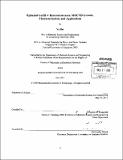| dc.contributor.advisor | Eugene A. Fitzgerald. | en_US |
| dc.contributor.author | Bai, Yu, Ph.D. Massachusetts Institute of Technology | en_US |
| dc.contributor.other | Massachusetts Institute of Technology. Dept. of Materials Science and Engineering. | en_US |
| dc.date.accessioned | 2012-03-16T16:03:15Z | |
| dc.date.available | 2012-03-16T16:03:15Z | |
| dc.date.copyright | 2009 | en_US |
| dc.date.issued | 2011 | en_US |
| dc.identifier.uri | http://hdl.handle.net/1721.1/69788 | |
| dc.description | Thesis (Ph. D.)--Massachusetts Institute of Technology, Dept. of Materials Science and Engineering, June 2011. | en_US |
| dc.description | "June 2011." Cataloged from PDF version of thesis. | en_US |
| dc.description | Includes bibliographical references (p. 121-126). | en_US |
| dc.description.abstract | Epitaxial Ge thin films are being investigated for many important roles in next generation microelectronics. Metal-oxide-semiconductor field effect transistors (MOSFETs) utilizing Ge channels have demonstrated dramatic performance enhancements over Si based technology. Theoretical studies have predicted that tensile strain enhances both electron and hole mobilities of Ge to levels much greater than those in unstrained or compressively-strained Ge and Si. Additionally, high enough levels of tensile strain have been postulated to alter the band structure of Ge to make Ge a direct-band-gap semiconductor. We investigated the physics and fabrication of Ge/III-V compound heterostructures, where the III-V compound material could serve as a tensile-strain-inducing template for subsequent Ge epitaxy. Through experimentation and the use of characterization techniques such as transmission electron microscopy (TEM), photoluminescence (PL), secondary ion mass spectrometry (SIMS) and spreading resistance analysis (SRA), we established correlations between the initial III-V compound surface stoichiometry and the structural, optical, and electronic properties of Ge thin films deposited on GaAs and AlAs templates. We determined that the highest structural quality Ge epitaxy initiates via a bond and exchange mechanism with the surface group III element atoms, whereas group V element atoms do not bond as effectively with Ge and thin film deposition processes that rely on Ge-group V binding processes lead to 'pitting' in Ge thin films. With the developed understanding of the growth mechanisms, we successfully fabricated high quality tensile-strained Ge thin films and quantum dots on InxGaixAs templates. Tensile strain levels as high as 0.58% in Ge thin films and 1.37% in Ge quantum dots were achieved. However, the film deposition methods that facilitated the highest structural quality also led to unintentional doping characteristics that affected the electrical and optical properties of the tensile-strained Ge epitaxial structures. Nevertheless, we designed processing sequences that led to the first demonstration of room temperature, Ge direct band gap luminescence from Ge/III-V compound heterostructures. We parlayed our advancements in Ge/Ill-V compound heterostructure fabrication to demonstrate a novel process for the fabrication of GaAs-on-Insulator (GaAsOI). The combination of GaAs/Ge/GaAs heterostructure establishment, room temperature oxide-oxide bonding methods, and XeF2-based sacrificial etching of Ge, led to the successful fabrication of GaAsOI on a small scale. We tested the implementation of our process on a full wafer scale and determined the process was kinetically limited by the lateral Ge etch process. We adapted the Deal-Grove oxidation model to establish a model to understand the relationships between lateral etch rate, lateral etch distance, release layer thickness, channel displacements, and the radius of curvature of the donor wafer. Our Ge/III-V compound heterostructure research advanced the understanding and stateof- the-art processing of such structures. We established methods and elucidated challenges for future research targeted toward demonstrating novel Ge-based devices and advanced large-diameter engineered substrates. | en_US |
| dc.description.statementofresponsibility | by Yu Bai. | en_US |
| dc.format.extent | 126 p. | en_US |
| dc.language.iso | eng | en_US |
| dc.publisher | Massachusetts Institute of Technology | en_US |
| dc.rights | M.I.T. theses are protected by
copyright. They may be viewed from this source for any purpose, but
reproduction or distribution in any format is prohibited without written
permission. See provided URL for inquiries about permission. | en_US |
| dc.rights.uri | http://dspace.mit.edu/handle/1721.1/7582 | en_US |
| dc.subject | Materials Science and Engineering. | en_US |
| dc.title | Epitaxial Ge/Il-V Heterostructures : MOCVD growth, characterization, and applications | en_US |
| dc.title.alternative | MOCVD growth, characterization, and applications | en_US |
| dc.type | Thesis | en_US |
| dc.description.degree | Ph.D. | en_US |
| dc.contributor.department | Massachusetts Institute of Technology. Department of Materials Science and Engineering | |
| dc.identifier.oclc | 777363426 | en_US |
